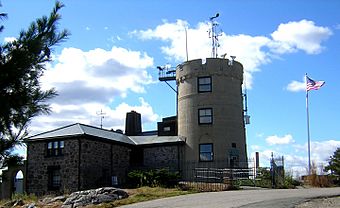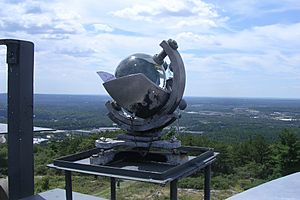Blue Hill Meteorological Observatory facts for kids
|
Blue Hill Meteorological Observatory
|
|

View from the east
|
|
| Location | Blue Hills Reservation, Milton, Massachusetts |
|---|---|
| Built | 1885 |
| Architect | Arthur Rotch; George T. Tilden |
| Architectural style | Late Gothic Revival |
| MPS | Blue Hills and Neponset River Reservations MRA |
| NRHP reference No. | 80000665 |
Quick facts for kids Significant dates |
|
| Added to NRHP | September 25, 1980 |
| Designated NHL | December 20, 1989 |
The Blue Hill Meteorological Observatory in Milton, Massachusetts is a very important building for understanding weather history in the United States. It sits on top of Great Blue Hill, about 10 miles south of Boston, Massachusetts. This observatory holds the record for the longest continuous weather observations in North America.
It was also where scientists first used kites to study the atmosphere in the 1890s. Later, in the 1930s, they helped develop the radiosonde, a device that sends weather data from high in the sky.
Abbott Lawrence Rotch started the observatory in 1884. It quickly became a leader in the new science of meteorology, which is the study of weather. Many early scientific measurements of the upper atmosphere were made here. Scientists used kites to carry weather instruments high up. This helped them learn about wind speeds, air temperature, and humidity at different heights. This information became super important for predicting weather.
By 1895, the observatory was making very accurate weather forecasts. On August 4, 1894, the first "atmospheric sounding" in the world happened here. A weather kite carried a special thermometer 2,030 feet above sea level. On October 8, 1896, a weather kite reached a record height of 8,740 feet (2,665 meters). During the Great New England Hurricane of 1938, the observatory recorded the strongest wind gust ever directly measured in a hurricane: 186 miles per hour (299 km/h).
The observatory is still active today. It keeps adding to its weather database, which is now over 100 years old. It stands as a monument to weather science in the United States.
Contents
History of the Observatory
Choosing the Location
The Blue Hill Meteorological Observatory was started by an American meteorologist named Abbott Lawrence Rotch in 1885. When he finished college in 1884, Rotch had a plan. He wanted to build a weather observatory on top of Great Blue Hill. This hill is ten miles south of Boston, Massachusetts, inside the Blue Hills Reservation. This reservation is a huge public park, about 6,000 acres (24 square kilometers).
Rotch picked this spot because at 635 feet, it was the highest point near the Atlantic Ocean on the East Coast, south of central Maine. This high location gave early weather scientists a special chance to record extreme weather. It also allowed them to try out new weather-recording tools.
Building the Observatory
The observatory building was finished by the end of 1884. The first regular weather observations began on February 1, 1885. Rotch became the first director. He paid for the observatory himself until he passed away in 1912. Then, he left it to Harvard University with money to help run it.
The building was designed by architects Rotch & Tilden. The first part had a two-story round tower and a living area. This area included two bedrooms, a dining room, and a kitchen. In 1889, a two-story east wing was added. This gave more space for research, daily tasks, and a library.
In 1902, a two-story west wing was built. It had a new library and more work space. A strong steel fire door and brick wall connected the library to the older stone building. The library roof was made with special tiles by the Guastavino Company.
The observatory used local stone from Great Blue Hill for its main parts. The roofs were covered with Copper sheathing. In 1905, a stone wall and iron fence were put up. This helped keep the building and instruments safe and gave staff privacy.
The first stone tower had a problem. Wind-driven rain got through its walls, harming the instruments and records. Also, vibrations from instruments on top of the tower caused structural issues.
So, in 1908, the old tower was taken down. A new, stronger three-story concrete tower was built in its place. This new tower was 20 feet 6 inches wide and 32 feet 8 inches high. It was designed in a style called late Gothic Revival. Concrete was chosen to make sure the tower was very stable and durable, especially in strong winds. The tower has a decorative top and a fancy edge with small block-like shapes. Its windows are double-hung and have a slight arch above them on the first and second floors.
The new tower provided a stable, weather-resistant place for accurate instrument readings. The director's office is on the first floor. The weather bureau is on the second floor. A laboratory and access to the roof are on the third floor. Various wind gauges and other weather instruments are on the tower's roof. The observatory still has barometers and other tools from the late 1800s. These old instruments are used to check the modern ones. This helps keep the accuracy of the weather data that goes all the way back to 1885.
In 1962, a metal tower was built next to the west wing. It had a siderostat to collect sunlight and direct it inside for upper atmosphere studies. This project stopped after a few years. This tower, with its mirrors, is no longer used.
In 1980, the building was added to the National Register of Historic Places. It was called the "Great Blue Hill Weather Observatory." In 1981, a local group called the Blue Hill Weather Club took over the observatory. They planned to fix it up and create a weather museum there. The observatory would stay open to continue its long record of weather observations. The National Weather Service still uses an Automated Surface Observing System at the site.
A white marble stone is in the front yard of the building. It has a summary of weather data from 1885 to 1984. This stone honors Abbott Lawrence Rotch.
In 1989, the observatory was named a National Historic Landmark.
In 2021, a big renovation of the observatory started. It cost $2 million. The renovation was completed by April 2023. Many parts of the building were upgraded. This included a new concrete wall, new ceilings, new windows, and better weatherproofing.
During the renovation, the observatory was closed to the public. However, the gift shop moved outdoors and stayed open. The renovation did not stop the daily weather observations. Now that the renovation is complete, there are new exhibits and programs for visitors.
How the Observatory Works
Under Rotch's leadership, the Blue Hill Meteorological Observatory quickly became famous. It was known for its new studies of the upper atmosphere. Rotch's work on cloud heights, directions, and speeds greatly helped our understanding of clouds in the early 1900s.
Rotch continued to work at the observatory until he passed away on April 7, 1912. In his will, he gave the observatory to Harvard University. He also left $50,000 to help with operating costs. Harvard ran the observatory until 1971. After that, they were no longer involved with the site. Harvard kept the money Rotch had left.
After 1912, the Blue Hill Meteorological Observatory kept working as an active weather observatory. Weather observations and recordings have continued every day since then. This provides modern meteorologists with a unique record of continuous weather data.
Because these recordings come from the same place with almost no environmental changes, they are very important for studying climate change. This information is especially valuable for scientists who study how climates change. Many other weather records are not as good because of changes in the environment, different ways of recording, or moving the observation site. Because of this, the National Oceanic and Atmospheric Administration (NOAA) named the Blue Hill Observatory one of 26 International Benchmark stations in the United States.
In the 1950s, a research group at the site used radar to track thunderstorms. They could see storms as far away as western New York State. This was part of a study to find out what causes lightning. The findings from this group were very important in developing the US weather radar program. The setup included a steel tower with a used military radar set. There were also several Quonset huts (half-cylinder buildings) and box trailers. A chain-link fence surrounded the area. Group members were ready to watch the radar whenever strong storms could be seen. They also collected data from a network of amateur weather observers who sent in their findings by mail. This time period was also when Dr. Charles Brooks, a famous director of the observatory, ended his long career. He was known for accurately predicting the path of the powerful New England Hurricane of 1938.
Major Accomplishments
Since 1885, the people working at the observatory have written almost 900 scientific papers. These papers describe the important scientific work done at Blue Hill. The observatory's first 100 years show a great history of helping meteorology grow. Weather measurements have been taken daily since the observatory first opened in 1885. This makes it one of the oldest continuously active weather and climate monitoring stations in the United States.
See also
 In Spanish: Observatorio meteorológico de Blue Hill para niños
In Spanish: Observatorio meteorológico de Blue Hill para niños
- List of astronomical observatories
- List of National Historic Landmarks in Massachusetts
- National Register of Historic Places listings in Milton, Massachusetts
Images for kids







